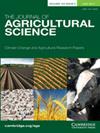生长温度影响高粱中木质纤维素的含量,并可能导致饲用高粱基因型饲料价值的显著变化
IF 1.7
4区 农林科学
Q2 AGRICULTURE, MULTIDISCIPLINARY
引用次数: 0
摘要
高粱(Sorghum bicolor, L.)Moench)是畜牧业中绿色饲料的合适来源。然而,其作为牲畜饲料的使用受到高浓度木质纤维素的限制。研究了采收环境和发育阶段对饲用高粱品种木质素、纤维素和半纤维素含量的影响。在Egerton大学(0°22'S;纳库鲁县东经35°55°),荣来(北纬0°23°;纳库鲁县35°51 e)和马里加特(0°46 n;在2019年和2020年在肯尼亚的Baringo县35°98 e)。采用完全随机区组设计,在孕穗期和成面团期对20个不同基因型高粱进行取样。对样品进行纤维素、木质素和半纤维素含量分析。记录植株生长、抽穗至50%的天数和日平均温度。纤维素、半纤维素和木质素含量在基因型和三种环境中有所不同。在埃格顿孕穗期取样的E6518系纤维素含量最低(17.02%),而在马里加特的IS11442系在面团期取样的纤维素含量最高(43.87%)。在Marigat生长的高粱木质素高于Egerton和Rongai,而在面团期收获的高粱纤维素、半纤维素和木质素浓度高于孕穗期收获的高粱。日平均温度变化显著的地点对3个参数的影响均显著(p > 0.05),其中埃格顿高粱的木质纤维素含量最低,荣来次之,马里加特次之。到抽穗50%,木质素与株高和日数呈正相关。但回归分析表明,抽穗至50%的天数与总温度呈负相关。作物发育阶段、基因型和环境决定了饲料高粱中木质素、纤维素和半纤维素的浓度。适当的高粱饲料的推荐应考虑当地的生长温度和收获的发育阶段。本文章由计算机程序翻译,如有差异,请以英文原文为准。
Growing Temperature Influence Lignocellulose in Sorghum and Could Lead to a Significant Variation in Feed Value of Fodder Sorghum Genotypes
Sorghum (Sorghum bicolor (L.) Moench) presents a suitable source of green fodder in the livestock sector. However, its use as livestock feed is limited by a high concentration of lignocellulose. A study was conducted to evaluate the influence of environment and developmental stage of harvesting on lignin, cellulose, and hemicellulose concentration of selected fodder sorghum cultivars. A field experiment was laid in a randomized complete block design and replicated three times at Egerton University (0°22′S; 35°55′E in Nakuru county), Rongai (0°23′N; 35°51′E in Nakuru county) and Marigat (0°46′N; 35°98′E in Baringo county) in Kenya in the years 2019 and 2020. Twenty different genotypes of sorghum were grown in a randomized complete block design and sampled at the booting and dough stages of development. The samples were analyzed for cellulose, lignin, and hemicellulose content. Plant growth, number of days to 50% heading, and daily average temperatures were recorded. Cellulose, hemicellulose, and lignin content varied among genotypes and across the three environments. The lowest cellulose content was recorded in line E6518 when sampled at the booting stage at Egerton (17.02%) while the highest concentration was recorded in IS11442 (43.87%) from Marigat at the dough stage. Lignin was highest in sorghum grown at Marigat than at Egerton and Rongai while sorghum harvested at dough stage had higher cellulose, hemicellulose, and lignin concentration than at booting stage. Location which distinctively varied on average daily temperature had a significant (p > 0.05) effect on the three parameters with sorghum grown at Egerton showing the lowest lignocellulose content followed by Rongai and Marigat, respectively. Lignin was positively correlated with plant height and days to 50% heading. However, regression analysis showed a negative relationship between days to 50% heading and the total sum of temperature. Crop developmental stage, genotype, and environment determine the lignin, cellulose, and hemicellulose concentration in fodder sorghum. The recommendation of suitable sorghum fodder for a region should consider local growing temperature and the developmental stage of harvesting.
求助全文
通过发布文献求助,成功后即可免费获取论文全文。
去求助
来源期刊

Journal of Agricultural Science
农林科学-农业综合
CiteScore
2.80
自引率
5.00%
发文量
68
审稿时长
1.4 months
期刊介绍:
The Journal of Agricultural Science publishes papers concerned with the advance of agriculture and the use of land resources throughout the world. It publishes original scientific work related to strategic and applied studies in all aspects of agricultural science and exploited species, as well as reviews of scientific topics of current agricultural relevance. Specific topics of interest include (but are not confined to): all aspects of crop and animal physiology, modelling of crop and animal systems, the scientific underpinning of agronomy and husbandry, animal welfare and behaviour, soil science, plant and animal product quality, plant and animal nutrition, engineering solutions, decision support systems, land use, environmental impacts of agriculture and forestry, impacts of climate change, rural biodiversity, experimental design and statistical analysis, and the application of new analytical and study methods (including genetic diversity and molecular biology approaches). The journal also publishes book reviews and letters. Occasional themed issues are published which have recently included centenary reviews, wheat papers and modelling animal systems.
 求助内容:
求助内容: 应助结果提醒方式:
应助结果提醒方式:


